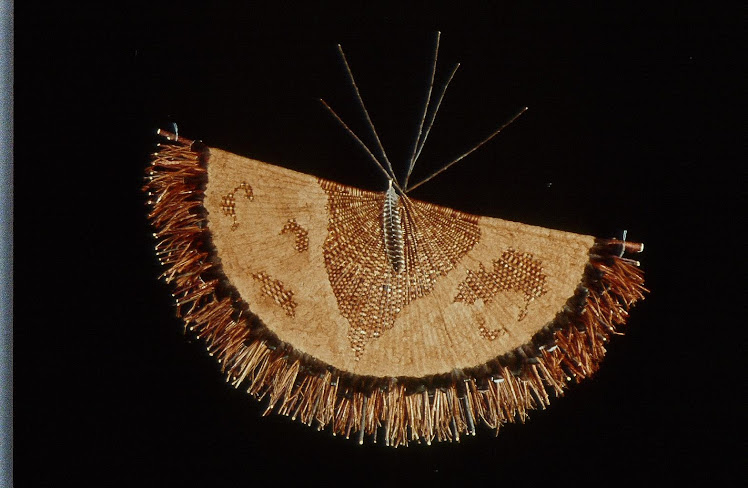 |
| grass fan 28"x20"x2" | <><>
Summer has peaked in the Puget Sound area with temperatures in the 90's, clear skies, and gentle breezes from the North. This is the time my thoughts flow to the harvesting of foliage from the many long-leaved plants and grasses I love to use for making cordage for weaving.
From our garden, or with permission from the gardens of others, I harvest handful-sized bundles of leaves and grasses, keeping in mind to leave behind plenty of leaves and seed so the plants may continue to be nourished, and able to reproduce. I use rubber bands for holding the cut ends together, and I hang them over a clothes-line strung up under an eve of the house, out of direct sun-light to dry. I could use the sunlight if I wanted to, for bleaching out the color, but I tend to go for the natural greens. As the days shorten, and the grasses and leaves begin to loose their green, going towards pale yellows, tans, and rusts, I continue to harvest handfuls as the colors are changing, capitalizing on the quality of that change producing a range of colors for the cordage I make.
Siberian iris, crocosmia, Yellow flag iris, cattail, bulrush, common rush, and NW sweetgrass are a few of my favorite leafy, grass-like materials, as well as crocus, daffodil and other spring bulb foliage. Some compost-rescue materials available now through Autumn for cordage include corn husks and leaves, and onion, garlic and leek leaves.
After the materials have been cured, or dried, they can be stored until ready to use. I recommend storing them indoors, in a heated area, out of direct sunlight. Before you use them moisten them only enough to make them flexible. If you think ahead, lay them out on the grass the night before you use them. The dew from above, and the moisture from the earth, are just right for making them flexible for use.
I relish the sounds of the grasses and leaves in the gentle breezes as I gather. There are usually birds hiding in these moisture-loving places. Bugs abound, and wonderful scents are adrift in the swamps, bogs, lake edges, and estuaries where these precious plants help to purify our waters, mitigate floods, and provide habitat for creatures of all kinds.


No comments:
Post a Comment
Comments on this blog are moderated and approved once a month. Please be patient or email me directly at melindawestbasketry@gmail.com